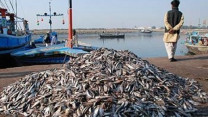Industrialists decry 48-hour gas outage
Export units in SITE facing shutdown as gas pressure remains zero

Industrialists of the SITE industrial area have lamented that their export-oriented businesses have come to a standstill as there has been no gas pressure for the last 48 hours.
SITE Association of Industry (SAI) President Abdul Rasheed stressed that Prime Minister Shehbaz Sharif and Minister of State for Petroleum Musadik Malik must take notice of the suspended gas supply to the industries of Karachi.
“Gas pressure remained low over the last two weeks, but for the past two days the pressure has dropped down to zero,” Rasheed said in
a statement. The suspended gas supply has halted production activities as many industrialists have closed their units due to unavailability of energy supplies to the SITE industrial area.
“If the industries do not receive gas with full pressure, they will not be able to meet export orders. In this situation, export-oriented units will not be in a position to fetch the much-needed foreign exchange for the country,” he said.
A source at SSGC said the gas supply system was disturbed by the recent heavy rains while supplies were uneven to different parts of Karachi. However, “the issue will be fixed soon”.
“High energy import is one of the main reasons for crisis in Pakistan,” said Topline Securities’ Senior Research Analyst
Sunny Kumar.
Pakistan’s own gas production has declined from 4,259 million cubic feet per day (mmcfd) in FY12 to 3,388 mmcfd in FY22 due to natural depletion and absence of sizeable discovery, he said.
The country could have saved $3 billion to $5 billion a year had gas production been maintained at 2012 levels, he pointed out.
He called for ramping up exploration activities, especially in the untapped areas, to increase domestic gas production, otherwise the pressure on external account would keep on affecting the overall economy.
In FY22, Pakistan’s liquefied natural gas (LNG) imports, an alternative source of fuel, amounted to
$5 billion. “Situation is really bad,” remarked Taurus Securities Head of Research Mustafa Mustansir. “The dilemma is that we are buying LNG at spot rates, which are very expensive.”
With the foreign exchange crunch, the government was looking to cut down imports, but the industrial closure due to gas shortage would not only hamper exports, but would also lead to layoffs, he pointed out.
Employers’ Federation of Pakistan (EFP) President Ismail Suttar said a majority of the global population had shifted to electric-powered stoves whereas in Pakistan most of the consumers used gas-powered stoves.
“Pakistan is one of the few countries that supplies gas to home consumers. These reasons have made the country hugely dependent on gas.”
“Pakistan is facing a severe energy crisis. Its most recent bid to import $1 billion worth of LNG failed to attract suppliers,” he said.
“We are facing low pressure gas problem in the SSGC franchise area. During the current week, few of the gas fields went off line more than twice with zero gas production for an extended time period. This resulted in depletion of the line pack at an accelerated rate,” SSGC said when asked for comments.
“After the recovery of these gas fields, SSGC’s demand and supply situation did not contribute towards the building of line pack. So there is complaint of low gas pressure on which the team is working on top priority. Gas curtailment has been initiated. However, the line pack is expected to be built over the weekend. From Monday, situation will be back to normal,” SSGC added.
Published in The Express Tribune, July 24th, 2022.
Like Business on Facebook, follow @TribuneBiz on Twitter to stay informed and join in the conversation.



















COMMENTS
Comments are moderated and generally will be posted if they are on-topic and not abusive.
For more information, please see our Comments FAQ